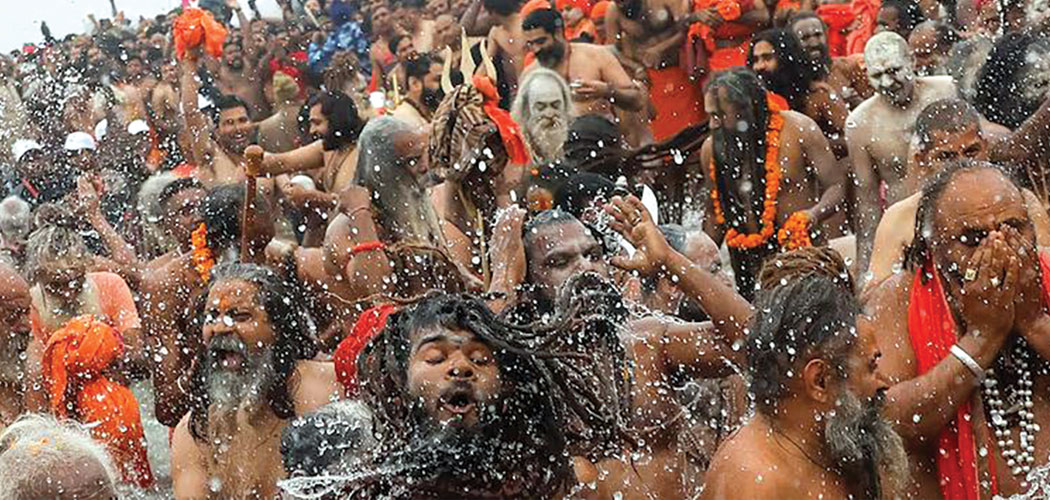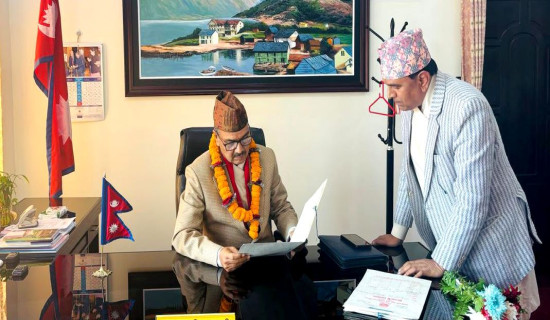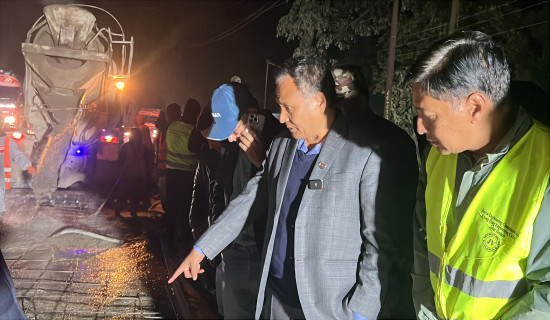- Sunday, 21 December 2025
Spiritual Confluence In Prayagraj
Uttar Pradesh, one of the 28 Indian states, is rich in sacred Hindu sites. The holy Ganga, Yamuna, Saraswati, and Sarayu, among others, pass through the cities of Varanasi, Mathura, Vrindavan, Ayodhya, and Prayagraj, which are associated with ancient Hindu mythology and divinity. The holy rivers and temples attract millions of Hindus annually. While most pilgrims hail from different corners of India with a population of approximately 1.5 billion, a large number of Hindu devotees from Nepal also visit the southern neighbour.
Nepal and India have shared a spiritual and cultural bond since time immemorial. Thousands of Indian pilgrims pay a visit to the religious places in Nepal, reflecting their age-old ties among the people of two close neighbours and transcending time and space. The number of Nepali pilgrims visiting India will grow substantially as the Maha Kumbh is underway (January 14 to February 26) in the holy city of Prayagraj in Uttar Pradesh, India. The mega festival is believed to have returned to Prayagraj, the city based near the sacred confluence of Ganga, Yamuna, and the mystical Saraswati, in 144 years.
“Once every twelve years, a city rises on the banks where the holy rivers meet. Millions of pilgrims travel thousands of miles to assemble at the Kumbh Mela,” states a documentary titled 'Mahakumbh: The River of Faith' by DD India. As per Sanatan Sansthan, a Hindu organisation, when Jupiter enters Aquarius and the sun and the moon enter Capricorn of Magha Amavasya, the Kumbha Mela is held at Prayagraj.
According to a January 13, 2025, BBC article, Hindu seer Mahant Ravindra Puri called the Prayagraj Kumbha Mela an "extra special," or "Maha Kumbha," unparalleled in 144 years.
Drips of elixir
The spill refers to the few drips of elixir, obtained from the Samundra Manthan (churning of the ocean), that dropped over four cities—Prayagraj, Haridwar, Ujjain, and Nasik—when gods and demons fought over the sacred drink with the power of granting immortality. As the fight went on for 12 celestial days—equal to 12 years on Earth—the Kumbha Mela festival is held every 12 years in the four cities. The mela is organised in all four cities, but the biggest festivals, where previous attendance records are broken, are always held in Prayagraj.

This time too, the records of the biggest gathering will be broken in Prayagraj. Alongside pilgrims from across the world’s seventh-largest country in land and the biggest in population, Nepalis also contributed to making it the world’s biggest-ever recorded gathering. Similarly, people from all around the globe, all walks of life, and religions also came to take a dip in the holy confluence.
The Indian and Uttar Pradesh governments, which began preparation for the Maha Kumbha around three years ago, have spent over 800 million USD and aimed for a handsome gain in return economically, more especially ‘spiritually’. The Maha Kumbha spreads across 4,000 hectares of land with over 160,000 tents, which can cater to over 400 million visitors, a number that is expected to have surpassed already with two more weeks to go.
Kumbha, a gathering, is related to Jupiter's partial or full revolution. Jupiter, aka Brihaspati, and other planets in the solar system have a major role in Hindu astrology and spirituality. It is not exactly known when the Kumbha gathering began. However, the Kumbha Mela (every 4 years), Ardh Kumbh Mela (every 6 years), Purna Kumbha Mela (every 12 years), and Maha Kumbha Mela (every 144 years) have been believed to be a continuity for several centuries.
The confluence of Koka and Koshi Rivers along the religious Barahakshetra, one of the char dham (four abodes of god) in Nepal in Sunsari of eastern Nepal, also hosted the Purna Kumbha in 2013. A special function was organised in the same holy site to promote Maha Kumbha last year as well. Barahakshetra has been hosting Kumbha since 2002 and also celebrates Ardha Kumbha and Purna Kumbha in the gap of six and 12 years, respectively, with the month of Magh (mid-January to mid-February) being the most auspicious period.
Thus, Magh sees an increase in the number of Hindu pilgrims throughout the confluences of Nepal and India. As a result, Barahakshetra is celebrating the Maha Kumbha with a special religious function currently as well. The confluence of the Trishuli and Kali Gandaki Rivers in Devghat Dham, which celebrates the Magh month annually, is also organising a Maha Kumbha recently.
The Indian and Uttar Pradesh governments invested in the Maha Kumbha of Prayagraj alongside the restoration of the Ram Mandir in Ayodhya and the beautification of the riverbank of the Ganga River in Varanasi, among others. Nepali Hindu priests call for similar measures regarding the proper conservation and promotion of religiously, historically, and spiritually important sites. The Matsya Purana, one of the 18 major puranas in Hinduism, states, “The sins disappear by the utterance of the name of the Ganges; the sight of her leads to prosperity.”
It is not that the sins disappear only if one takes a holy dip during the Kumbha events but whenever one visits the rivers, which are all holy in Hinduism. So, why Kumbh? DD India, in its Maha Kumbha documentary, shows Sri M, a spiritual teacher and social reformer, calling the Kumbha a gathering to ponder over the meaning of life and basic elements of the universe. “The idea was to get people from all different systems of belief of Sanatan Dharma. The idea was they all come together so that there can be a meaningful dialogue between them,” Sri M says.
Prayagraj has served as the centre of the many Maha Kumbha organised throughout Nepal and India recently.
The number of visitors to Prayag is comparable to none, but the other religious sites and confluences have also flourished with seers and priests. Prayagraj’s area of fair currently feels like a different place, giving the vibes of a different yuga where righteousness dominates injustice.
Among the millions who gather, the presence of sadhus and santas is particularly striking—ash-covered ascetics, draped in saffron, lost in deep meditation or passionately preaching wisdom. Alongside them, pilgrims with weary eyes, carrying the weight of their struggles, arrive in search of solace and divine blessings. Some seek liberation from worldly suffering, while others yearn for spiritual awakening. As they bathe in the confluence of sacred rivers, hope and devotion glisten in their gaze, reflecting the belief that these holy waters will cleanse their sins and wash away their burdens.
In the region where Hindu texts have been the guidance of mankind, the Maha Kumbha in Prayagraj has the opportunity to delve into contemporary issues and help create a system where the world can be a better place for all. But as the region grapples with the influence of modern culture that threatens the rich spiritual tradition and history, the Maha Kumbha has sparked the thought of the need to reflect within and lead a life without harming others.
Locals could be seen helping visitors by reaching out to them. Thousands of volunteers and security officials have been mobilised throughout the Maha Kumbha in an organised manner, with the deployed individuals in each of over two dozen sectors well-behaved, calm, well-versed in the territory, and keen to help.
Extended influence
The scenario in Varanasi and Ayodhya during the Maha Kumbha was completely different from what I experienced during my visit to the two cities a couple of months ago, just before the festival of Tihar. Situated at the edge of a triangle-shaped formation, the three UP cities of Prayagraj, Varanasi, and Ayodhya are around 200 km away from each other. The way Varanasi and Ayodhya have carried out logistics and other preparations for the pilgrims shows their commitment to making the Maha Kumbha in Prayagraj a grand success. This is indeed a mesmerising spectacle that highlights the importance of cooperation and bonding between the people of faiths.
Good highways make road travel easy as train tickets are limited; therefore, pilgrims visiting the Maha Kumbha in Prayag have extended their travel to the other two cities—Ayodhya and Varanasi—as well. So, the feel of Maha Kumbh does not disappear unless an individual leaves the whole UP. It also provides time to stay in the spiritual environment a little longer, igniting different thoughts of life and ways of living.
(Paudel is a journalist at this daily.)




-square-thumb.jpg)











